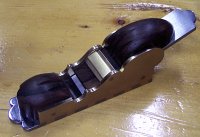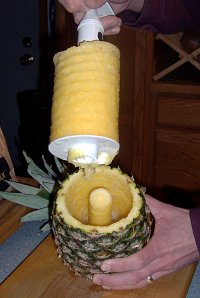I just finished Chappell and Bringhurst's A Short History of the Printed Word (Second edition). It's a good review of book publishing from pre-Gutenberg up to the present, and has lots of great photos of old books and typefaces. Near the end, Bringhurst discusses the decline in the quality of books:
The degradation of the book goes hand in hand with the destruction of the forests, the pollution of the water, the pollution of the air. It is one more way of reaping profits now and leaving nothing to the people of the future. (page 296)
Indeed.

I'm one of the moderators (ListMom) of an OldTools email list. This year, a bunch of the galoots on the list got together and had planemaker Wayne Anderson build me and the other ListMom a chariot plane. The plane is absolutely gorgeous, with brass sides perfectly dovetailed into the steel bottom, and some sort of tropical hardwood that holds the iron perfectly. It's a bevel-up plane, and in my initial, ahem, testing, it handles the toughest grain I had to throw at it.

Click on the images for a larger view. In the side shot you can see Wayne's signature, as well as the microscopically tight mouth on the plane.
And if that wasn't enough, the left over money went into a Lee Valley gift certificate. I've already got a shoulder plane and a couple books on the way. Thanks to everyone on the list for their generosity.
It's a great list, with great folk. If you're at all interested in working wood by hand, or in collecting old hand tools, check it out.

On this week's America's Test Kitchen the gadget guy demonstrated a device that cores, peels, and slices pineapples. The Cooks Illustrated review says that using a knife and carving the pineapple manually does yield more fruit (31 vs. 24 ounces of a 64 ounce pineapple), but this gadget makes it incredibly simple. The whole process took less than five minutes, required virtually no skill, and I got a whole bunch of pineapple slices to eat for lunch. According to my nutrition software, a single slice or raw pineapple contains 79% of your daily value of vitamin C, 34% for Manganese, and 5% of your daily fiber. All for less than 2% of your daily calories!
Here in Fairbanks, pineapple isn't exactly cheap (I think it was around $1.90 / pound, which means it's almost $4.00 for a pound of usable fruit), but I think that eating real, fresh food, is worth the money, and adding an occasional pineapple to my diet is a good thing.

I guess I was wrong about the flying squirrel being disturbed by the boreal owl we had last week. The squirrel has been visiting our feeders regularly since, and we've even seen a pair of them on occasion. His eyes are actually black, but they're so large that when the flash hits them, they turn completely red. The photo has been edited so they're white instead.
My wife took the photo. You can see some more of her pictures at her Flickr page.

A few days ago we had this little guy show up at the tree nearest to our house. The photo was taken by my wife, standing about four feet away from it. We've got a whole bunch of bird feeders all over the deck, and we think the owl was probably harvesting voles that come out to eat birdseed that makes it to the ground. We often see a flying squirrel occupying the same perch on that tree, but he's been absent for a few days now.
You can see larger versions of the photograph at my wife's Flickr page.